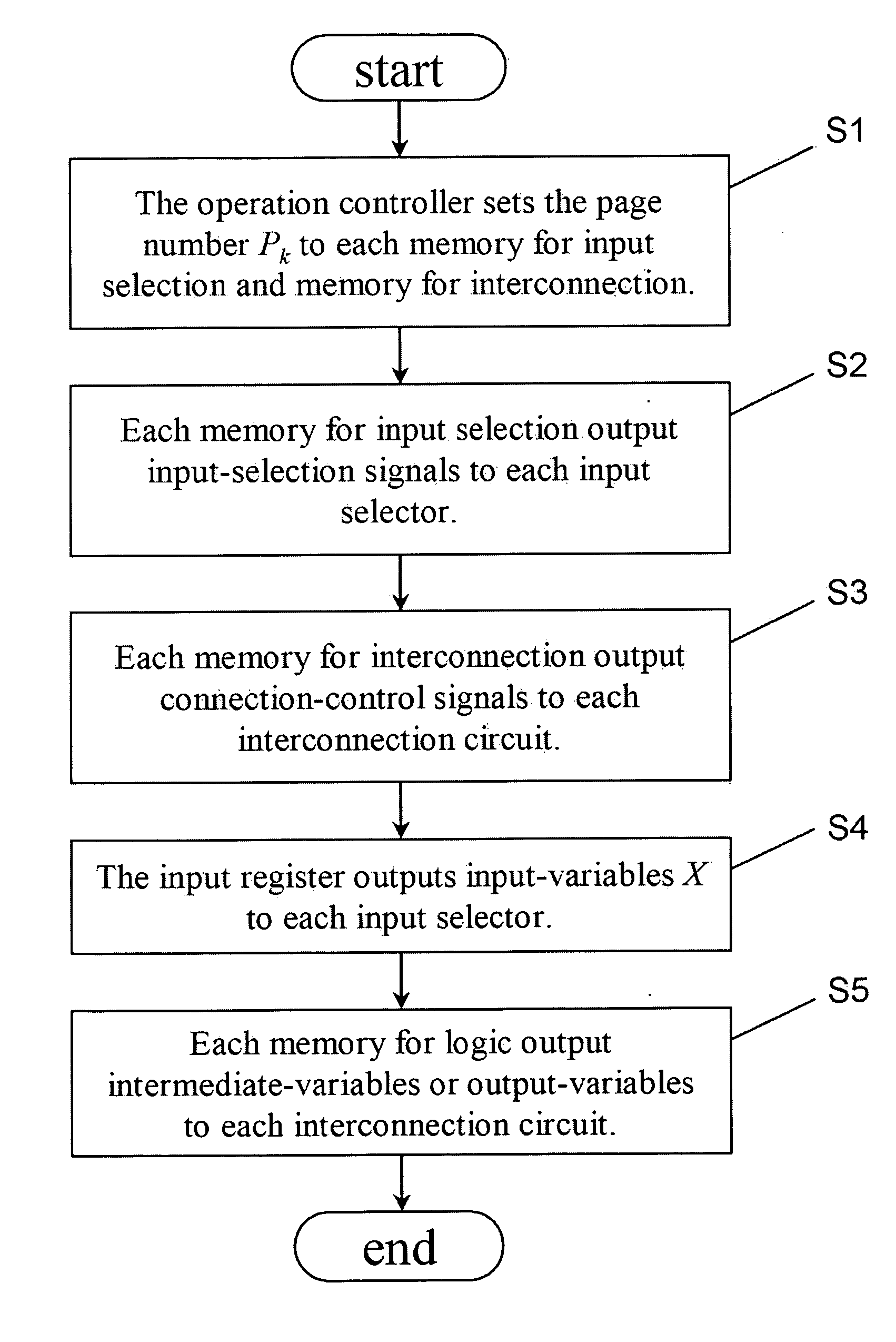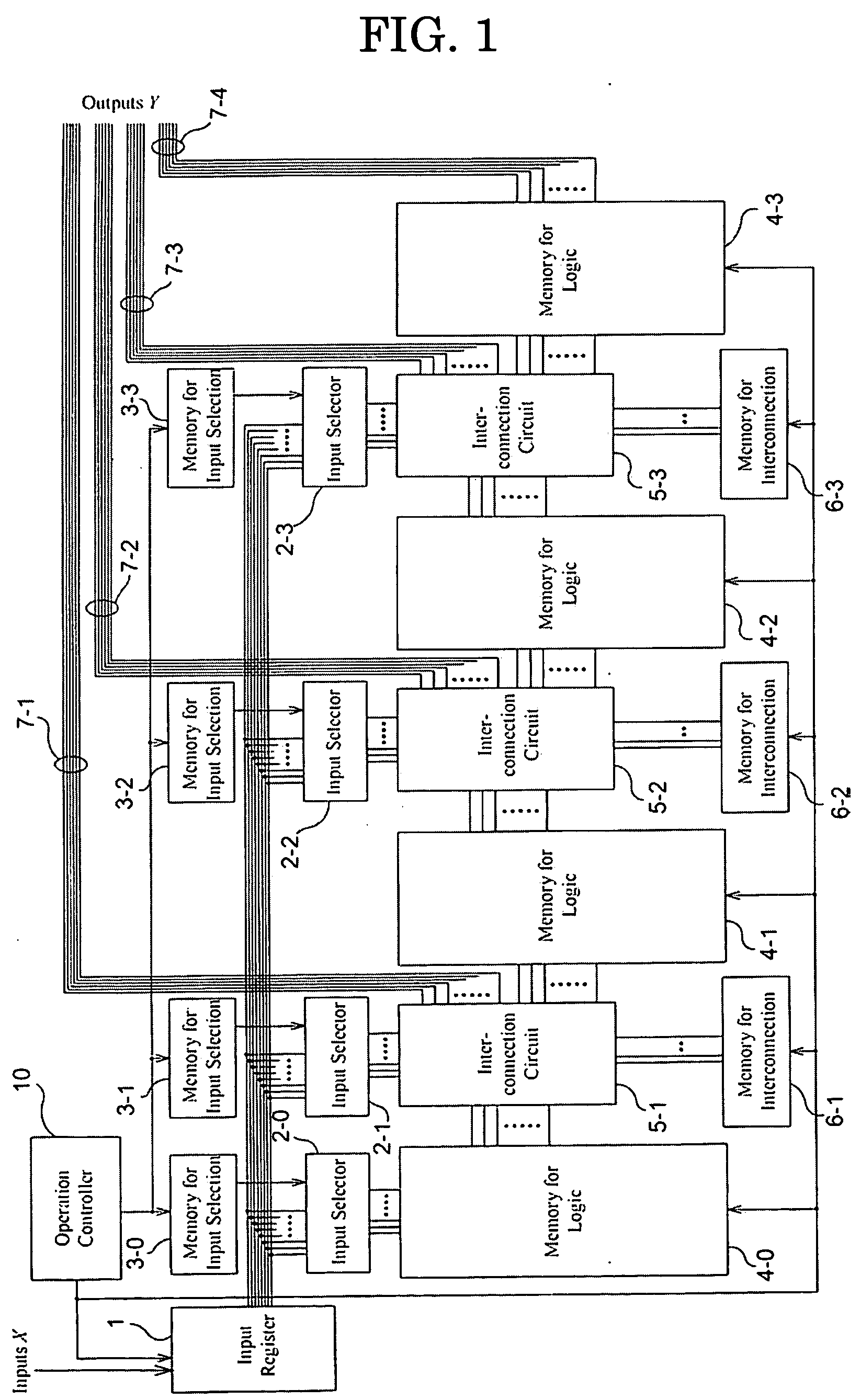Programmable Logic Device
a logic device and programmable logic technology, applied in the field of programmable logic devices, can solve the problems of difficult performance estimation of logic circuits, difficult to predict interconnection delay, time-consuming work, etc., and achieve the effect of increasing the number of levels of lut cascade, and increasing the degree of freedom for design
- Summary
- Abstract
- Description
- Claims
- Application Information
AI Technical Summary
Benefits of technology
Problems solved by technology
Method used
Image
Examples
embodiment 1
II. Embodiment 1
[0144]The simplified block diagram of the PLD in accordance with EMBODIMENT 1 of the present invention is illustrated in FIG. 1.
[0145]The PLD for EMBODIMENT 1 of the present invention consist of an input variable register (1); input selectors (2-0)-(2-3); memories for input selection (3-0)-(3-3); memories for logic (4-0)-(4-3); interconnection circuits (5-1)-(5-3); memories for interconnections (6-1)-(6-3); and an operation control part (10).
[0146]The input variable register (1) stores the inputs X=(x1, . . . , xn): where X has n variables, and is used for the operation of objective logic function ƒ(X), where n is a natural number. Input variables X are sent through the external input lines to the input variable register (1). Memories for logic (4-0)-(4-3) store the truth tables of decomposition functions {ƒi; iε{0, 1, 2, 3}}: where they are obtained by decomposing the objective logic function ƒ, and are stored as LUTs. In this embodiment, the number of stages of the...
example 1
(End of Example 1)
III. Embodiment 2
[0215]The simplified block diagram of the PLD in accordance with EMBODIMENT 2 of the present invention is illustrated in FIG. 17.
[0216]The feature of this EMBODIMENT is as follows: a part of the output lines of the input selectors (2-1)-(2-3) are directly connected to the inputs of memories for logic (4-1)-(4-3) without using the interconnection circuits (5-1)-(5-3). In many practical logic functions, at least one external input variable is connected to an input of the memories for logic (4-1)-(4-3). That is, at least one output line of the input selectors (2-1)-(2-3) is often connected to the input of the memories for logic (4-1)-(4-3). Therefore, in a PLD used in practice, if a part of the output lines of input selectors (2-1)-(2-3) is connected directly to the input of memories for logic (4-1)-(4-3) without using the interconnection circuits (5-1)-(5-3), then we can decrease the number of the input lines of the interconnection circuits (5-1)-(5-...
embodiment 3
IV. Embodiment 3
[0217]The simplified block diagram of the PLD in accordance with EMBODIMENT 3 of the present invention is illustrated in FIG. 18.
[0218]The first feature of this EMBODIMENT is that the PLD has; the input selectors (30-1)-(30-3) that select the input variables, and send them directly into the memories for logic (4-1)-(4-3) without using the interconnection circuits (5-1)-(5-3) and the memories for input selection (31-1)-(31-3) that stores the information for the connection of the input selectors (30-1)-(30-3); in addition to the input selectors (2-1)-(2-3) that select the input variables and send them to the interconnection circuits (5-1)-(5-3). Moreover, the second feature of this EMBODIMENT is that in this PLD, a part of the intermediate variables is directly connected from the output of the memory for logic (4-(i−1)) (iε{1, 2, 3}) in the preceding stage, to the memory for logic (4-i) of succeeding stage, without using the interconnection circuits (5-1)-(5-3).
[0219]B...
PUM
 Login to View More
Login to View More Abstract
Description
Claims
Application Information
 Login to View More
Login to View More - R&D
- Intellectual Property
- Life Sciences
- Materials
- Tech Scout
- Unparalleled Data Quality
- Higher Quality Content
- 60% Fewer Hallucinations
Browse by: Latest US Patents, China's latest patents, Technical Efficacy Thesaurus, Application Domain, Technology Topic, Popular Technical Reports.
© 2025 PatSnap. All rights reserved.Legal|Privacy policy|Modern Slavery Act Transparency Statement|Sitemap|About US| Contact US: help@patsnap.com



